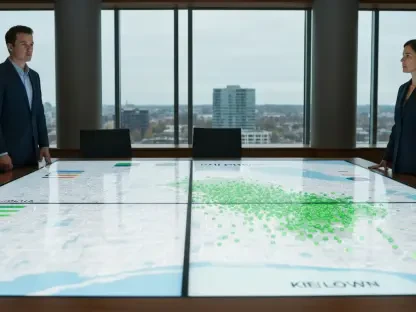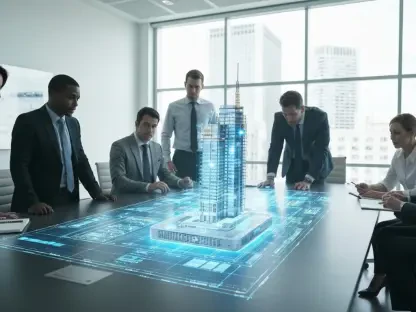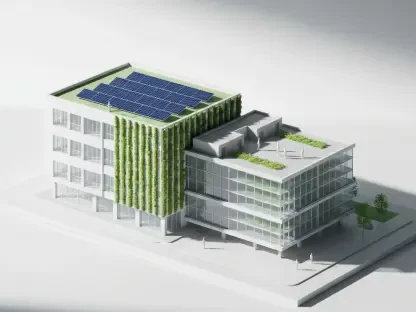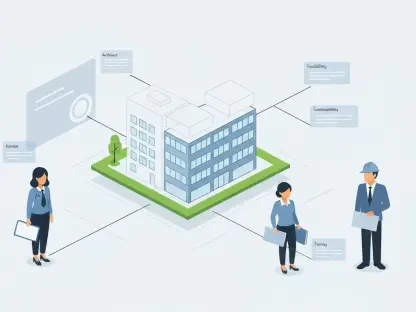In Arden Hills, Minnesota, an ambitious redevelopment project at the 427-acre site of Rice Creek Commons is underway, transforming the former Twin Cities Army Ammunition Plant into a beacon of sustainability. The plan aims for carbon neutrality and highly efficient designs, offering a glimpse into the complex interplay between visionary environmental goals and the challenges faced in bringing them to reality. This transformation looks to set a benchmark for sustainable development, where the commitment to drastically minimizing carbon emissions marks a significant departure from traditional reliance on fossil fuels. With the groundbreaking of the Micro Control Company headquarters on the site, there is a mix of excitement and caution due to the practical constraints that such aspirational targets invariably entail.
Balancing Environmental Ambition with Real-World Constraints
The initiative to enforce fully electric operations at Rice Creek Commons displays a notable leap toward advancing environmentally conscious urban development. Through this directive, the project symbolizes a shift in a state predominantly relying on fossil fuels for heating, setting a formidable standard others might look to emulate. Despite this, Ryan Companies, leading the development, have faced substantial hurdles. The rapid timeline, with sustainability guidelines solidified just as construction plans were being finalized, highlighted the friction between idealistic environmental targets and the realities of development timelines and budgets. This tension is not unusual in the realm of sustainable projects, where groundbreaking intentions often collide with the necessity for timely execution and budgetary constraints.
The drive for sustainable innovation at Rice Creek Commons necessitated deviations from the original plans, underscoring the complexities inherent in such ambitious endeavors. For the Micro Control Company headquarters, flexibility became as paramount as innovation. The demands of executing a carbon-neutral project within tight schedules and within financial limitations meant that adjustments were inevitable. This delicate balance of pushing for innovation while yielding to real-world constraints reflects a broader trend seen in sustainable development initiatives. The enthusiasm that surrounds the project remains tempered by the understanding of these profound challenges and the need for adaptive strategies that bridge this gap.
Navigating Sustainability Standards and Waivers
To successfully navigate the ambitious sustainability standards set for Rice Creek Commons, Ryan Companies had to contend with a series of vital waivers that would allow progress within practical constraints. These waivers, though necessary, further unveiled the inherent tension between the lofty ideals of sustainability and the practical confines dictated by schedules and budgets. Each waiver represented a unique consideration that developers had to weigh while striving to fulfill the project’s environmental aspirations. Such negotiations reflect broader industry challenges, where maintaining ideal sustainability standards is not always feasible amidst real-world limitations.
A significant challenge arose from the need to balance the envisioned sustainability with the project’s timelines. The requirement to secure waivers underscored the urgent demand for flexibility in construction protocols. These waivers were implemented with the understanding that swift adaptations were crucial to meeting deadlines without undermining the project’s environmental goals. As such, the compromises these waivers presented were essential in keeping the project aligned with its timeline while still aiming for advancements in energy efficiency. The flexibility shown through these modifications highlights a pragmatic approach essential in executing large-scale sustainable projects.
Embracing Innovative Green Technologies
Rice Creek Commons showcases innovations that underline its commitment to advancing green technology within building practices. The inaugural building, destined to house Micro Control Company, serves as a testament to this pioneering approach. Equipping the structure with geothermal heating and cooling makes it nearly 90% electric, offering a tangible representation of how progressive the project aims to be. The infrastructure of this facility is engineered to facilitate future solar installations and to support electric vehicle charging stations. Through such adaptability, the project commits to future-proofing, looking ahead as energy demands continue to evolve.
The initial accomplishments at Rice Creek Commons serve as a catalyst for further sustainable development within the site. By integrating cutting-edge technologies like geothermal systems, the project illustrates a forward-thinking attitude towards comprehensive sustainability. Future-proofing the site heralds a significant advancement in how developments can evolve alongside shifting technological landscapes. This proactivity is crucial as energy needs become increasingly stringent, demanding compatibility and readiness for emerging technologies. The nuanced design elements present in the initial phase set a precedent and provide a model for subsequent stages of the development, embodying an ethos of continuous ecological improvement.
The Nuances of Waiver Requests
The complex landscape of waivers highlights the multifaceted challenges developers at Rice Creek Commons must navigate to maintain the project’s sustainability aspirations. Several waivers were crucial to bridging the gap between ambitious environmental goals and the tangible necessities of development. Avoiding immediate LEED certification exemplified a critical concession due to cost and time pressures. While LEED certification is often synonymous with sustainable excellence, the decision to bypass it underscored the financial and temporal realities dictating immediate priorities, showing how strategic compromises can align with overarching goals.
Another major waiver pertained to maintaining natural gas systems as a backup measure due to Minnesota’s harsh winters. The cultivation of purely geothermal energy proved financially and technologically daunting in such an unforgiving climate. This decision illustrated the pragmatic approach required when pioneering efforts confront traditional constraints. Furthermore, the delay in solar array installations underscored another layer of complexity; finding the right partners to realize these aspirations depicted the intricate dance between ambition and execution. These examples testify to how balancing idealism with economic prudence is essential for long-term viability and success.
The Role of Partnerships in Sustainability
Partnerships have been identified as an indispensable asset in overcoming the formidable challenges associated with large-scale sustainable projects like Rice Creek Commons. By collaborating with various stakeholders, the developers can better align their aspirations with the economic realities that govern such initiatives. The delay in installing comprehensive solar arrays and reducing EV charging infrastructure highlights the project’s reliance on strategic partnerships to realize these aspects. Partnerships broadened financial capacity and logistical resources, making it possible to achieve sustainability goals that would otherwise remain out of reach.
Beyond economic considerations, partnerships also bring critical expertise and innovation that drive the project further. Engaging with entities that specialize in solar technology, for instance, opens avenues for cutting-edge solutions that may not have been previously accessible. The symbiotic relation between the project and its partners ensures continuous learning and adaptation. As Rice Creek Commons evolves, the role of partnerships will likely expand, demonstrating how collaborative efforts contribute substantially to achieving broad sustainable development goals. This collaborative nature underscores a shift towards a more integrated approach in realizing environmental objectives.
Broader Trend in Sustainable Development
The development at Rice Creek Commons mirrors broader trends in sustainable development, capturing the spirit of initiatives aimed at enhancing energy efficiency and reducing fossil fuel dependency. Ramsey County officials envision the project as a trailblazer setting new standards for efficient and renewable energy use. The commitment to sustainable designs and practices reinforces this site’s position at the forefront of broader national and regional discussions about energy and environmental policies. This vision aligns with a growing consensus on the pressing need for transformative approaches to urban development.
This project is not just about the present; it is a learning platform that anticipates future technological advancements to ease subsequent sustainability efforts. As technologies evolve, so too will the possibilities for integrating even more advanced sustainable solutions. The lessons gleaned from Rice Creek Commons offer valuable insights into crafting future policies and practices aimed at tackling climate change effectively. The project’s ongoing innovations provide a testament to the dynamic nature of sustainable development, where each step lays groundwork for new opportunities and advancements in the field.
A Blueprint for Future Initiatives
The push for fully electric operations at Rice Creek Commons marks a significant step toward environmentally conscious urban development, setting a benchmark in a state heavily reliant on fossil fuels. Ryan Companies spearheading this project, however, faces substantial challenges, embodying the friction between lofty environmental ideals and practical realities like development timelines and budget constraints. As sustainability guidelines were established concurrently with construction plans, this tension became evident—a common scenario in sustainability ventures where ambitious goals often clash with execution necessities and fiscal realities.
For the Micro Control Company headquarters, adaptability proved as crucial as innovation in navigating these complexities. Aiming for a carbon-neutral result within strict timelines and fiscal boundaries mandated inevitable adjustments. This struggle epitomizes the broader trend in sustainable development, where the quest for progress is balanced by real-world limitations. The project’s excitement is tempered by an awareness of its significant hurdles, necessitating adaptive strategies to reconcile these contradictions.









